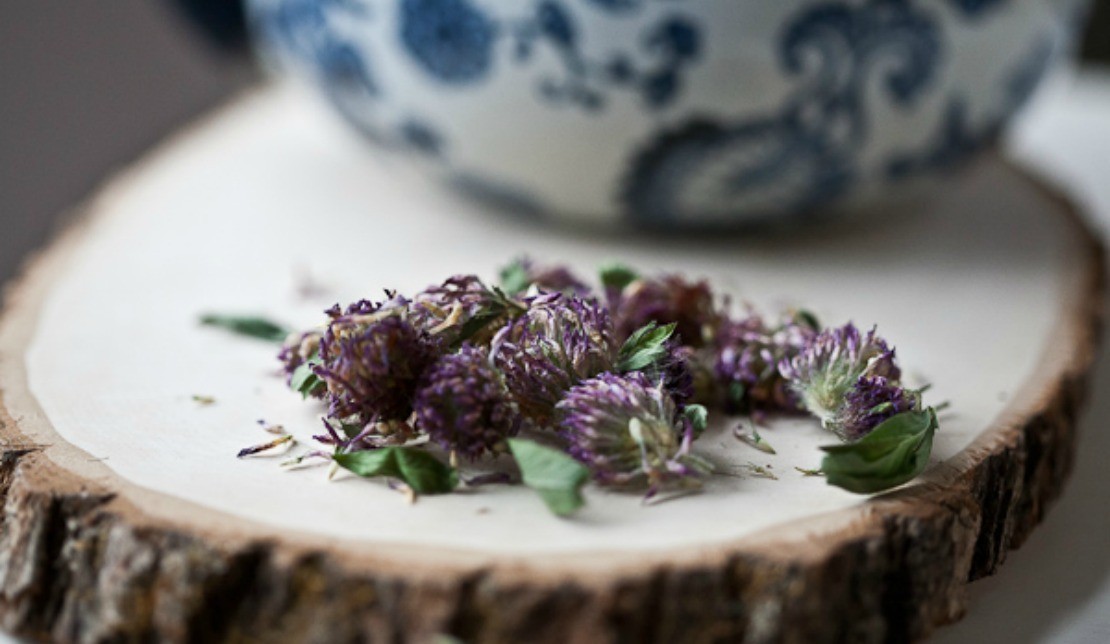
How to Make an Easy Red Clover Tea: Red Clover, Red Clover, Bring Good Health on Over
Red clover (Trifolium pratense) is a well-known “weed” introduced to North America by European colonists and is now commonly found in fields, roadsides, and in yards from May until September. This herbal perennial in the pea family (Fabaceae, also known as Leguminosae) roots itself with a long taproot and rises up with a slender, hollow, and hairy stem. The blossom surfaces with its two three-parted, and white V-embossed leaflets in a cheerful burst of purple-pink petals. In the sweet, flowering head, one will find deliciousness and an assortment of beneficial constituents. Not bad for a “weed”! In this article you will find everything from uses to dosage to a delicious red clover tea recipe.
Traditional Uses of Red Clover
In many cultures, the color and shape of flowers reveal properties of the plant (this concept is called the Doctrine of Signatures). The color red is often associated with blood purifying and fever-busting benefits in Cherokee and other aboriginal medicines. Ben Charles Harris stated that“the color may also suggest the astringency or healing effect of a plant in external or skin disorders arising from blood impurities” (Graves, 2000).
This herb has been used historically for skin conditions, fever, colds, and lung issues especially in children. At one time, red clover was smoked as an anti-asthmatic. Let’s look at the present day benefits of red clover.
Modern Uses For Red Clover
Energetics: sweet, salty, cool
Meridians/Organs affected: liver, heart, lungs
Part used: flowers
Active constituents: Phenolic glycosides, flavonoids, coumarins, cyanogenic glycosides, isoflavones, salicylates, polysaccharides
Properties: alterative, antispasmodic, expectorant
Like other alteratives, red clover is used to assist the body in removing metabolic waste products. These blood-purifying properties are used for skin conditions such as eczema, psoriasis, and other skin irritations that crack and ooze. A red clover tea is generally mixed with yellow dock and nettles to handle these conditions. More directly as a poultice, chopped red clover with a little water can be applied to skin lesions.
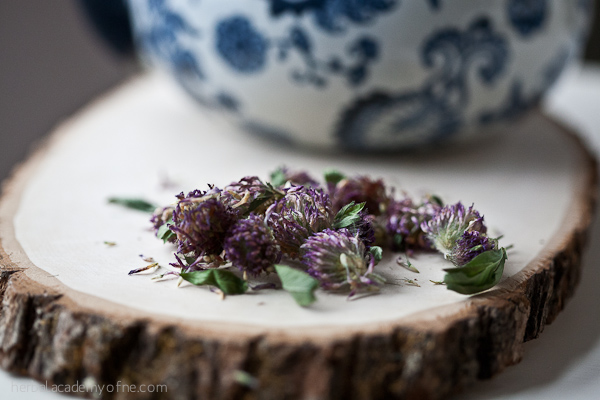
As an expectorant and antispasmodic, red clover is used to counteract fevers, inflamed lungs, and bronchitis. Red clover contains a mild sedative property, which complements its antispasmodic effects for cough. The flower is also used for inflammatory conditions associated with arthritis and gout.
Compounds in red clover include phytoestrogenic isoflavones such as genistein, diadzen, formononetin and biochanin A. Studies of individual components of red clover show some cancer fighting action in vitro. For example, in one 2012 study, formononetin induced cancer cell apoptosis (cell death) in estrogen receptor- positive breast cancer cells (Chen et al, 2012).
For gynecological support, red clover is often suggested to help symptoms during menopause. In 2005, a randomized, double-blind, placebo controlled study looked at the effects of red clover isoflavones on 60 postmenopausal women, concluding that supplementation “significantly decreased menopausal symptoms and had a positive effect on vaginal cytology and triglyceride levels” (Hidalgo, et al 2005). In 2009, red clover isoflavones were “effective in reducing depressive and anxiety symptoms among postmenopausal women” (Lipovac, 2009). However, other studies have demonstrated mixed results and the largest study to date showed no improvements with hot flashes. (Note that these studies investigated commercial red clover isoflavones and not the whole flower and therefore do not accurately reflect how the whole herb will act.)
Red Clover Safety
Avoid in pregnancy or if you have a known hormone-sensitive condition.
Do not use with pharmaceutical blood thinners or with the herb melilot (Melilotus officinalis). The coumarin derivatives in red clover may increase the chance of bleeding. Because red clover side effects may include slow blood clotting, stop taking it at least two weeks prior to surgery, and avoid if you have Protein S deficiency or any other type of coagulation disorder.
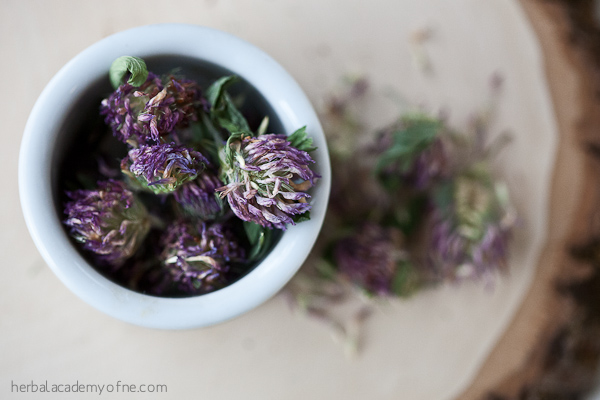
Cancer is a serious condition and must be attended to by health professionals. Inform them if you’re considering red clover to ensure there are no conflicts with other herbs, surgical procedures, or medications.
Harvesting and Drying Red Clover
Finding red clover is usually not an issue in the zones where it grows. As a precaution, be aware of possible yard chemicals or roadside pollution when wildcrafting. Do not harvest under roof drip lines and choose clover growing well away from roads.
When wildcrafting, never take all of the plants in a community – leave enough red clover for pollinators and our fellow earthlings who use these plants for food.
Red clover blossoms are ready to be plucked one to two weeks after first bloom, and can be harvested up to three times in the establishment year. Simply pop the blossom off, leaving the rest of the plant undisturbed. If in use by an insect, wait politely or move along to another plant!
Normally, we recommend harvesting herbs after dew evaporation to prevent molding, but red clover is one of the few exceptions. If you pluck clover when it’s dry, it will turn brown. To retain the lovely color, pluck the flower from the top of the stem in the morning when there is still a little dew on the blossoms. Place the blossoms in a basket or on a drying rack and place in a dark, warm, ventilated, and dry place. Ensure that the blossoms are well spaced and not touching each other, and turn frequently while drying. Depending on conditions, your clover will be dry in 1 – 2 weeks.
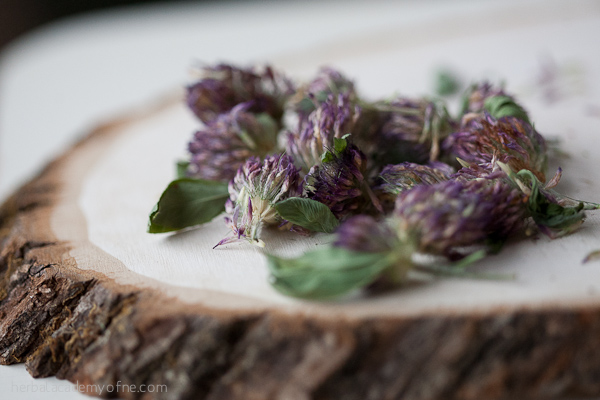
If buying dried red clover flowers, ensure they are from a responsible organic source. We have included a link in the recipe to such a source. Again, the red clover flowers are the medicinal element of this herb to be infused or tinctured.
Ways to Use Red Clover
Red clover adds a beautiful color and a mild spicy-sweetness to tea blends. Try adding it to lemonade!
Red Clover Flower Tea
“Roses are red, violets are blue. If health is important, drink red clover brew!”
- Add the dry red clover flowers into the hot water in a heat safe vessel.
- Steep for 15 minutes.
- Drink 3 times a day.
Red clover can also be tinctured. For folk tincturing instructions, please see our tincturing tutorial.
Red Clover Tincture
Alcohol (at least 80 proof)
Clean glass Mason jar with clean unused lid
Fine cheese cloth
Strainer
Large bowl for straining
- Place blossoms into jar and pour alcohol over the blossoms, ensuring all are covered.
- Seal your jar and place your clover tincture in a dark cabinet.
- Let the tincture sit for 6 weeks and shake occasionally.
- Check alcohol level in case of absorption. Add more alcohol if needed to ensure full coverage.
- After 6 weeks, open jar and strain with a cheesecloth held by a strainer into a clean container.
- Transfer red clover tincture into individual dropper bottles if preferred.
- Standard adult amounts are 2-6 mL of tincture three times a day.
This article is written by Sharyn Hocurscak, herbalist and President of Herbal Community of Central Massachusetts.
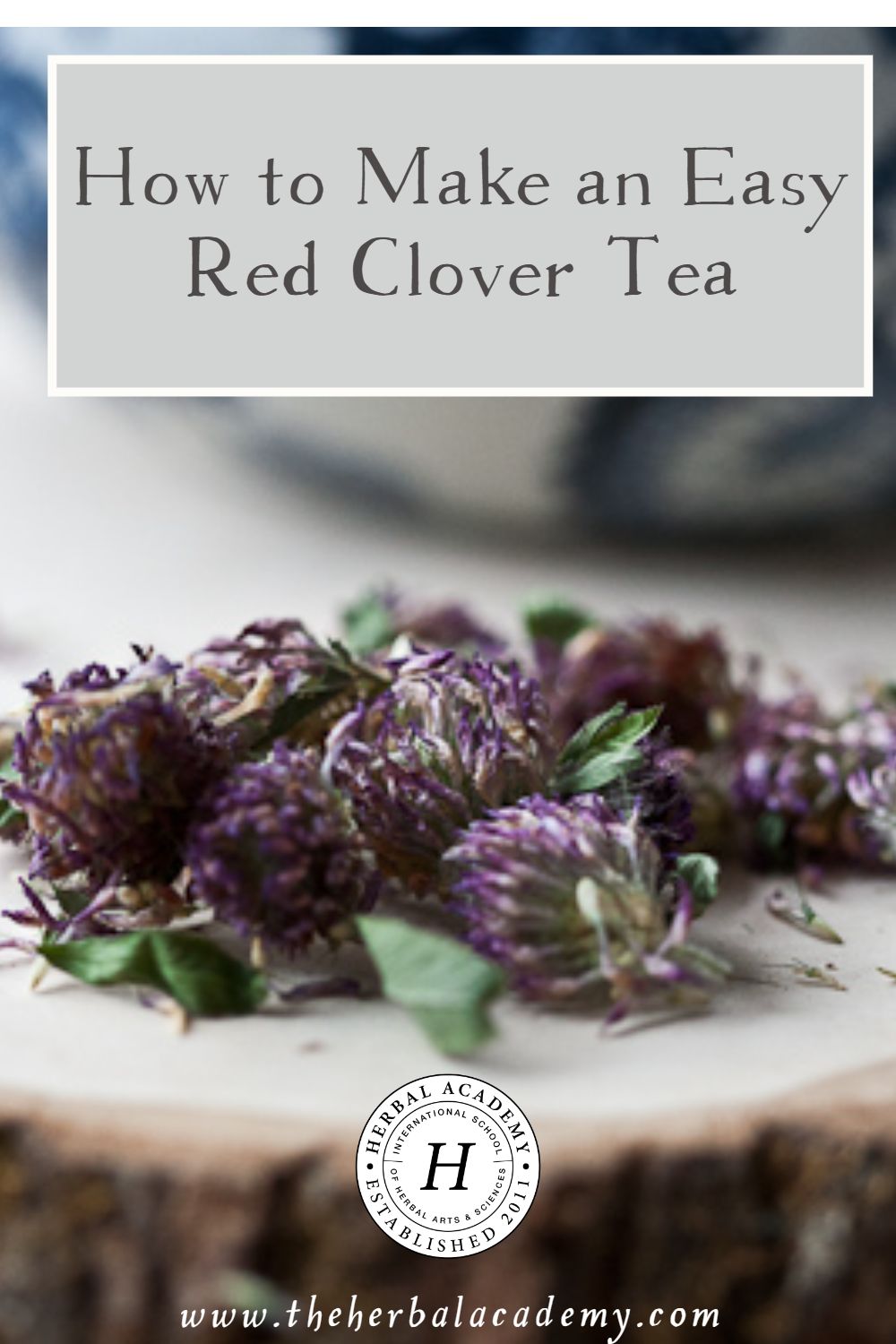
REFERENCES
Chen J, Sun L. (2012) Formononetin-induced apoptosis by activation of Ras/p38 mitogen-activated protein kinase in estrogen receptor-positive human breast cancer cells. Horm Metab Res. Dec;44(13):943-8.
Foster, Steven and Duke, James A. (2000) Peterson’s Field Guide of Medicinal Plants and Herbs of Eastern and Central North America. Boston and New York: Houghton Mifflin Co.
Graves, Julia. (2012 ) The Language of Plants, A Guide to the Doctrine of Signatures.
Great Barrington, MA: Lindisfarne Books Steiner Books of Anthrosophic Press, Inc.
Hidalgo LA, Chedraui PA, Morocho N, Ross S, San Miguel G. (2005) The effect of red clover isoflavones on menopausal symptoms, lipids and vaginal cytology in menopausal women: a randomized, double-blind, placebo-controlled study. Gynecol Endocrinol. Nov;21(5):257-64.
Hoffman, David (2003) Medical Herbalism: The Science and Practice of Herbal Medicine.
Rochester, Vermont: Healing Arts Press
Lipovac M, Chedraui P, Gruenhut C, Gocan A, Stammler M, Imhof M. (2009) Improvement of postmenopausal depressive and anxiety symptoms after treatment with isoflavones derived from red clover extracts. Maturitas. 2010 Mar;65(3):258-61.
Tierra, Michael (1992) Planetary Herbology 2nd Edition. Twin Lakes, WI: Lotus Press







